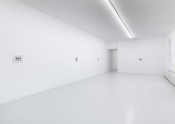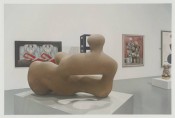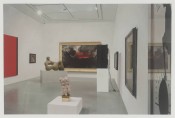Andrew Grassie and Rachel Withers in conversation: 10 June 2008, the artist’s studio, London.
Andrew Grassie: Come on in… The tripod’s out because I’m recording everything at the moment and I thought I’d photograph the interview. Or maybe just the seats where we’re sitting. So if you don’t mind?
Rachel Withers: Go right ahead!
AG: It could be useful as a kind of title. Or if the interview text starts on the right hand page, there could be a tiny thumbnail of the studio with us on the left.
RW: Well, this audio recorder is working, which is a relief. I’ve had more than one bad experience with recording equipment… one time my gear failed completely and I had to reinvent the whole interview from my notes.
AG: How did that turn out?
RW: Surprisingly enough, quite well. I suspect the artist in question didn’t notice! But a propos of that story, I’ve been thinking that questions of documentation and origination have a particular pertinence for this interview. All your tempera paintings are transcriptions from photographic sources, and consequently they raise all kinds of questions about documentary transparency, authorship, authenticity… Likewise, this interview will be based in transcription. But both the completed text and a significant number of your tempera paintings rely on retrospective adjustments, additions and inventions for their apparent seamlessness. I’m thinking about the way some of your exhibitions are made up of paintings representing views of the very exhibition they’re in, including a tiny painting of “themselves”. In other words, they transcribe a photographic referent into which the painted transcription itself has been “smuggled”, retrospectively.
AG: Well, in a sense they’re “smuggled” in advance, as they exist in the painting’s representation of the show before it’s hung in the gallery. My earliest show along those lines was at the Collective Gallery in 1994. I made a series of nine tempera paintings of the gallery space, each hanging on the wall that it represented. In fact I’ll do a similar thing for this show: I’m making a painting that shows my installation in the Talbot Rice Gallery. I’ll hang it near the entrance, and it should be the last thing you see as you exit the show. So it will show you the view you’ve already seen. As you can see, I still have to fill in all my works on the walls.
RW: This looks like a perfectly finished painting transcribed from a photo of an empty gallery. And you’re going to “hang” it with your work, just like the real hang? Your paintings will be “dropped in” on top of the white walls?
AG: And of course there’ll be the reflections on the floor to do as well. Here’s the source photograph, which was taken whilst an exhibition by Alan Michael was on the walls, and you can see how reflective the floor is.
RW: Now that’s quite a surprise. Your painting has emptied the gallery in the source photograph of its paintings, and now it’s ready to be filled with your work. There’s something slightly uncanny about this.
AG: This aspect of the project was important for me, as both Pat Fisher and I were not overly comfortable with the idea of a straight “retrospective” of the last ten years’ work. So the show will represent new work such as this alongside selected paintings drawn from past projects and bodies of work. It’ll include about 30 paintings, all of them in tempera. Along with this work there’s another new painting that I’m making primarily for the catalogue. And there’s some archival material that I’m playing around with. The gallery has these nice old museum vitrines which I’ll use to show “outtakes” — source photographs and so on. There’s also an upper room, the round room, that opens onto the historic collection, and that’ll show a video representing maybe 24 hours of my exhibition hang in progress. We’ll record it on CCTV and project it on a small scale so that it’ll look like a painting. Real time, a fixed camera angle, just people walking through. I had in mind Bruce Nauman’s video installation of his studio at night, just letting the camera run, as the mouse ran round the space. It’s important for me that the show becomes an object in itself, as well as a survey.
RW: Understood. In the last three solo shows of yours that I’ve seen — New Hang at the Art Now space at Tate Britain, Group Show at Mobile Home, Installation at Maureen Paley’s gallery — each individual painting is emphatically a component in an overarching strategy. Each show forms a totality, it’s a time-based work in its own right. In New Hang, for example, you “curated” a deliberately incongruous show of works from the Tate collection, and installed them in the Art Now space, made source photographs and then, finally, installed the paintings in the space so that each image’s point of view replicated what one would have seen in your “new hang” (except — am I right? — that the Tate works were never there all at the same time)… It seemed to me that you’d created a really brilliantly complicated conceptual object — a network of not just three- but four-dimensional relationships. I imagine a mathematician might be able to visualise that as a geometrical pattern. My brain can’t do it, but I like the idea of that mesh of lines plotted out in both space and time.
AG: There’s an underlying web in all those shows, yes. In various ways they were all quite formalised. Each show involved me making a visual map of the space to dictate where the work would hang. Both New Hang and Group Show presented implausibly curated shows, but the experience of each was actually quite different. Group Show was a strange mix of works lent to me for a day by many different artists. In this case the angles and vantage points of the eight source photographs were chosen as specific representations of the show rather than as part of a rational system. In the final installation of the paintings, each was hung in the middle of the frame where the camera was pointing. In this way you “walked into” the painting as you approached it. The underlying aim was to create a kind of déjà vu in the viewer. As you saw each painting, it would recall a memory of the space you’d previously seen.
In the Tate show I worked out a web of points of view on paper. The trajectories were like the ball in a pinball machine, bouncing of the walls, boing boing boing… This plan showed visitors a kind of optical route round the show. I couldn’t expect anyone actually to take it, though maybe some people did. I wanted lots of variation: long shots that incorporated the whole space, more intimate close-ups, shots showing views taken from both the right and the left. I wanted to formalise everything clearly so there was a reason for everything, in contrast to Group Show, which was more random. I wanted it to be absolutely airtight.
RW: I certainly got that feeling. I felt the “privileged” viewpoint in the Tate show, if there was one, was right in the middle of the room (as opposed to hugging the walls with one’s nose glued to each work). From the centre the images are little tiny punctuation marks; optically speaking they’re just blips on the retina, yet conceptually, they dominate and structure the space. Like those burglar alarms in movies: light beams crossing in space, controlling the totality of its volume…
Continue reading in Andrew Grassie: Painting as Document, Talbot Rice Gallery, The University of Edinburgh 2008 pp.4-7
Text © Rachel Withers and Andrew Grassie, 2008. Images © Andrew Grassie.


